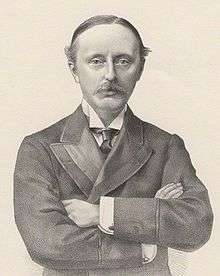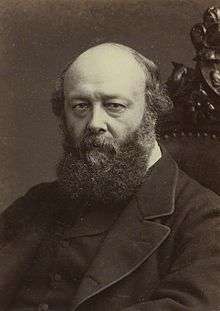Edward Stanhope
| The Right Honourable Edward Stanhope | |
|---|---|
 | |
| President of the Board of Trade | |
|
In office 19 August 1885 – 28 January 1886 | |
| Monarch | Victoria |
| Prime Minister | The Marquess of Salisbury |
| Preceded by | The Duke of Richmond |
| Succeeded by | A. J. Mundella |
| Secretary of State for the Colonies | |
|
In office 3 August 1886 – 14 January 1887 | |
| Monarch | Victoria |
| Prime Minister | The Marquess of Salisbury |
| Preceded by | The Earl Granville |
| Succeeded by | Sir Henry Holland, Bt |
| Secretary of State for War | |
|
In office 14 January 1887 – 11 August 1892 | |
| Monarch | Victoria |
| Prime Minister | The Marquess of Salisbury |
| Preceded by | W. H. Smith |
| Succeeded by | Sir Henry Campbell-Bannerman |
| Personal details | |
| Born |
24 September 1840 London |
| Died | 21 December 1893 (aged 53) |
| Nationality | British |
| Political party | Conservative |
| Alma mater | Christ Church, Oxford |
Edward Stanhope (24 September 1840 – 21 December 1893) was a British Conservative Party politician.
Background and education
Born in London, Stanhope was the second son of Philip Stanhope, 5th Earl Stanhope, by his wife Emily Harriet, daughter of General Sir Edward Kerrison, 1st Baronet. Arthur Stanhope, 6th Earl Stanhope was his elder brother and Philip Stanhope, 1st Baron Weardale his younger brother. He was educated at Harrow and Christ Church, Oxford. Stanhope studied law, being called to the bar at the Inner Temple in 1865. In 1861 he played three first-class cricket matches for Kent.
Political career
In 1874 Stanhope was elected to the House of Commons for Mid Lincolnshire, a seat he held until 1885, and then represented Horncastle until his death. He soon rose to a position of prominence within the party. In 1875 he became Parliamentary Secretary to the Board of Trade, and in 1878 moved up to Under-Secretary of State for India, where he was a key assistant to India Secretary Lord Cranbrook.
After the Tories' fall from power in 1880, Stanhope supported Commons leader Sir Stafford Northcote against younger Tories led by Lord Randolph Churchill in internal Conservative party squabbling. When the Conservatives returned to the power, Stanhope became Vice-President of the Committee of Council on Education, with a seat in the cabinet, and almost immediately thereafter President of the Board of Trade. He moved up to major cabinet office in Salisbury's second government, serving first as Colonial Secretary from 1886 to 1887 and then as Secretary of State for War from 1887 to 1892 following a cabinet reshuffle in January 1887.
As War Secretary, Stanhope fought for reform against the reactionary high officers – most notably the Duke of Cambridge, the Commander in Chief, and Sir Garnet Wolseley, the Adjutant-General. In spite of his own inexperience in military affairs and this formidable opposition, Stanhope achieved a fair amount, although it was his Liberal successor, Henry Campbell-Bannerman, who managed to push Cambridge into retirement.
Personal life
In December 1893, Stanhope died suddenly of a heart attack, aged 53.
References
External links
- Hansard 1803–2005: contributions in Parliament by Edward Stanhope
- CricketArchive: Edward Stanhope
| Parliament of the United Kingdom | ||
|---|---|---|
| Preceded by Weston Cracroft Amcotts Henry Chaplin |
Member of Parliament for Mid Lincolnshire 1874–1885 With: Henry Chaplin |
Constituency abolished |
| New constituency | Member of Parliament for Horncastle 1885–1893 |
Succeeded by Lord Willoughby de Eresby |
| Political offices | ||
| Preceded by George Cavendish-Bentinck |
Parliamentary Secretary to the Board of Trade 1875–1878 |
Succeeded by John Gilbert Talbot |
| Preceded by Lord George Hamilton |
Under-Secretary of State for India 1878–1880 |
Succeeded by The Marquess of Lansdowne |
| Preceded by A. J. Mundella |
Vice-President of the Council 1885 |
Succeeded by Sir Henry Holland, Bt |
| Preceded by The Duke of Richmond |
President of the Board of Trade 1885–1886 |
Succeeded by A. J. Mundella |
| Preceded by The Earl Granville |
Secretary of State for the Colonies 1886–1887 |
Succeeded by Sir Henry Holland, Bt |
| Preceded by W. H. Smith |
Secretary of State for War 1887–1892 |
Succeeded by Sir Henry Campbell-Bannerman |
